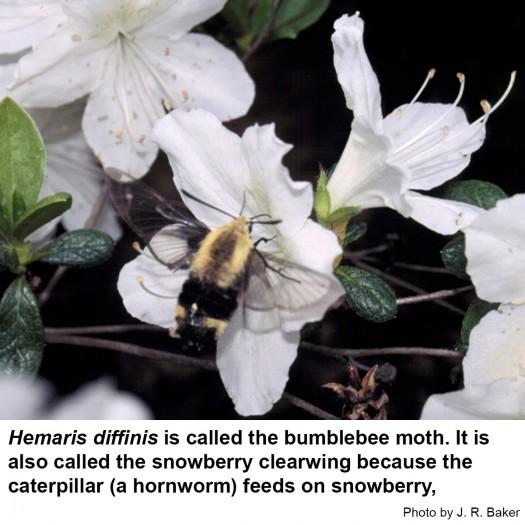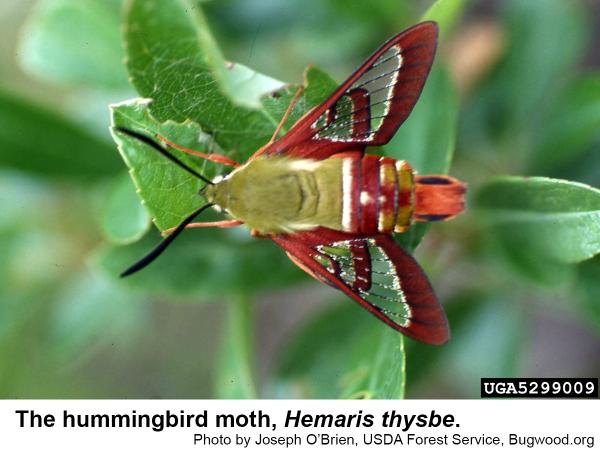Description and Biology
Sphinx moths in the genus Hemaris are remarkable because Hemaris diffinis resembles bumble bees and Hemaris thysbe vaguely resembles hummingbirds in flight. Hemaris diffinis is called the bumblebee moth. It is also called the snowberry clearwing because the caterpillar (a hornworm) feeds on snowberry. This moth has mostly black scales around clear portions of the wings, and the legs are black. The caterpillar is a pale green hornworm with a black horn and black spots along each side. A pair of pale lines runs down the back.
Hemaris thysbe is the hummingbird moth or common clearwing moth. It varies from other Hemaris moths in that the legs are pale and the wings have rusty scales. A pair of pale lines runs down the back. The caterpillars spin cocoons inside of which they pupate in leaf litter or in the soil. We have at least two generations per year in North Carolina.
Host Plants
Bumblebee moth caterpillar and hummingbird hornworms feed on dogbane, snowberry, honeysuckle, and dwarf bush honeysuckle. The caterpillars are almost never submitted for identification. Their moths visit just about anything that is in bloom.
Residential Recommendation
Bumble bees, carpenter bees and Hemaris moths often forage at the same flowers. Although they look like stinging insects, the Hemaris moths are completely harmless. Evidently their resemblance to stinging insects affords them some protection from predators. Because the caterpillars are rarely noticed, no control measures are recommended.
References
- Attributes of Hemaris thysbe, Hummingbird Clearwing. Anonymous. No Date. Butterflies and Moths of North America, Collecting and Sharing Data about Lepidoptera.
- Hemaris thysbe. Anonymous. 2013. Wikipedia, the Free Encyclopedia.
- Snowberry Clearwing or Bumblebee Moth (Hemaris diffinis). Anonymous. No Date. Research, Education, and Community Outreach, Ninnescah Fld. Sta. Kansas. Whitchita State Univ.
- Extension Plant Pathology Publications and Factsheets
- Horticultural Science Publications
- North Carolina Agricultural Chemicals Manual
For assistance with a specific problem, contact your local N.C. Cooperative Extension Center
This Factsheet has not been peer reviewed.
Publication date: April 19, 2013
Reviewed/Revised: May 7, 2023
N.C. Cooperative Extension prohibits discrimination and harassment regardless of age, color, disability, family and marital status, gender identity, national origin, political beliefs, race, religion, sex (including pregnancy), sexual orientation and veteran status.



